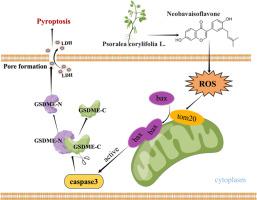Phytomedicine ( IF 7.9 ) Pub Date : 2023-05-09 , DOI: 10.1016/j.phymed.2023.154869 Yaru Li 1 , Renshuang Zhao 1 , Zhiru Xiu 2 , Xia Yang 1 , Yilong Zhu 2 , Jicheng Han 3 , Shanzhi Li 2 , Yue Li 2 , Lili Sun 1 , Xiao Li 4 , Ningyi Jin 5 , Yiquan Li 6

|
Background
Neobavaisoflavone (NBIF), a natural active ingredient isolated from Psoralea, possesses anti-inflammatory, anti-cancer, and antioxidant properties; however, the anti-tumor mechanism of NBIF has not been thoroughly investigated, and the inhibitory effect and inhibitory pathway of NBIF on liver cancer are still unknown.
Purpose
Our study aimed to explore the effects of NBIF on hepatocellular carcinoma and its potential mechanisms.
Methods
First, we detected the inhibition of NBIF on HCC cells by the CCK8 assay and then observed the morphological changes of the cells under the microscope. Besides, we analyzed the changes in the pyroptosis level of NBIF when inhibiting the cells through flow cytometry, immunofluorescence, and a western blot assay. Finally, we used a mouse tumor-bearing model to explore the effects of NBIF in vivo on HCCLM3 cells.
Results
NBIF-treated HCC cells exhibited specific features of pyroptosis. Analysis of pyroptosis-related protein levels revealed that NBIF primarily induced pyroptosis in HCC cells via the caspase-3-GSDME signaling pathway. Then, we demonstrated that NBIF impacted the protein expression of Tom20 by producing ROS in HCC cells, hence promoting the recruitment of Bax to mitochondria, activating caspase-3, cutting GSDME, and triggering pyroptosis.
Conclusions
By activating ROS, NBIF was able to trigger pyroptosis in HCC cells, providing an experimental basis for the future study of new treatments for liver cancer.
中文翻译:

新巴伐异黄酮通过 Tom20 感知活化的 ROS 信号诱导肝癌细胞焦亡
背景
新巴伐异黄酮 (NBIF) 是一种从补骨脂中分离出来的天然活性成分,具有抗炎、抗癌和抗氧化的特性;然而,NBIF的抗肿瘤机制尚未深入研究,NBIF对肝癌的抑制作用和抑制途径尚不清楚。
目的
我们的研究旨在探讨 NBIF 对肝细胞癌的影响及其潜在机制。
方法
首先,我们通过CCK8法检测NBIF对HCC细胞的抑制作用,然后在显微镜下观察细胞的形态学变化。此外,我们通过流式细胞术、免疫荧光和蛋白质印迹分析分析了抑制细胞时 NBIF 细胞焦亡水平的变化。最后,我们使用小鼠荷瘤模型来探索 NBIF在体内对 HCCLM3 细胞的影响。
结果
NBIF 处理的 HCC 细胞表现出细胞焦亡的特定特征。对焦亡相关蛋白水平的分析表明,NBIF 主要通过 caspase-3-GSDME 信号通路诱导 HCC 细胞焦亡。然后,我们证明 NBIF 通过在 HCC 细胞中产生 ROS 影响 Tom20 的蛋白表达,从而促进 Bax 向线粒体的募集,激活 caspase-3,切割 GSDME,并引发细胞焦亡。
结论
通过激活ROS,NBIF能够触发HCC细胞的细胞焦亡,为未来研究肝癌新疗法提供实验基础。



























 京公网安备 11010802027423号
京公网安备 11010802027423号